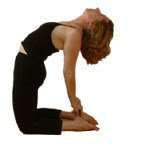Dhanurasana improves digestive, elimination, and reproductive function by reconditioning the entire alimentary canal. The kidneys, liver, abdominal organs and muscles are massaged. The pancreas and adrenal glands are toned balancing their secretions. The spinal column is realigned providing a good stretch to the ligaments, muscles and nerves. It can help correct hunching of the thoracic area of the spine. Opens the chest and stretches the front of your torso.
** Note ** Don't practice this pose before sleep at night because it simulates the adrenal glands and the sympathetic nervous system.
** Contraindications ** Do not practice this pose if you suffer from a weak heart, high blood pressure, hernia, colitis, peptic or duodenal ulcers.
The steps to practice Bow pose are:
- Lie with your stomach flat and forehead resting on the floor. Your arms and hands are beside your body.
- Bend your knees and draw the heels close to the buttocks. Grasp the ankles from the outside and place your chin on the floor. You are now in the starting position.
- Inhale as you engage your leg muscles and push your feet away from the body. As you continue to inhale, arch the back, lift your thighs, chest and head at the same time off the floor as high as you can without straining. Keep your arms straight. Now tilt your head back comfortably and gaze at your Third Eye. Your abdomen is supporting your entire body on the floor. Your legs are engaged, but the back and arms should be relaxed. Hold this position for 3-5 Ujjayi breaths.
- Exhale as you slowly relax your leg muscles and lower your legs, chest and head back to the starting position. Release the pose and relax on your stomach with your head turned to one side and your arms at your side with your palms facing upward. Alternate the turn of your head if you do multiple rounds of this pose. Breath here for a few breaths.
- Repeat steps 2-4 for as many rounds as you are comfortable.
- Push back into Balasana (Child's Pose) when you have completed as many rounds as you are comfortable with. Once you push back into Balasana you can bring yourself upright and move into a forward bend to counter the effects of the back bending.
Namaste,
Leslie Ottavi









